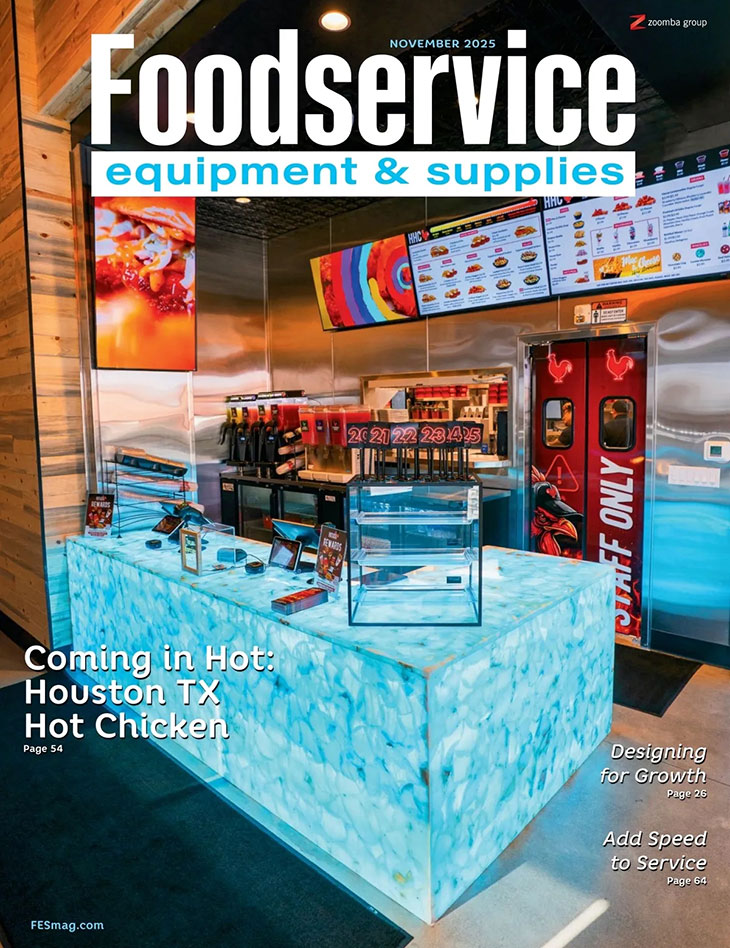As energy codes evolve and sustainability goals hold steady, commercial kitchens across the country continue to shift toward electric equipment. But, says Chef Mark Duesler of the Frontier Energy Food Service Technology Center (FSTC), the future of kitchen design isn’t binary.
 Chef Mark Duesler“The key is not electric versus gas,” Duesler says. “It’s: What’s best for your kitchen’s size, staff, and menu — and how do you keep it flexible as those things evolve?”
Chef Mark Duesler“The key is not electric versus gas,” Duesler says. “It’s: What’s best for your kitchen’s size, staff, and menu — and how do you keep it flexible as those things evolve?”
His advice? Take a measured, hybrid approach — and think of the kitchen as a system, not a collection of individual tools.
Hybrid Kitchens Offer the Best of Both Worlds
In many new builds, an all-electric kitchen may be required either by the operator or the municipality or both. In other instances, though, designing with both gas and electric equipment allows more flexibility — especially when factoring in available rebates, shifting operational needs, chef preferences and changing energy codes.
Not everyone can switch to all-electric overnight, and gas is cheaper and more energy efficient in certain parts of the country, Duesler says. Not to mention, the many rebates available for gas-powered equipment can make these items an appealing choice. “There’s a lot of money on the table with rebates—and operators shouldn’t leave it there,” Duesler says.
But even in the fine dining world, long dominated by open flames and French tops, electric cooking options such as induction are starting to prove their worth. At Rancho Pico Blanco, a luxury hotel on California’s Central Coast, the executive chef committed to removing natural gas appliances as part of the property’s broader decarbonization effort, Duesler notes. Recognizing the high heat load and energy intensity of traditional kitchens, the chef consulted the FSTC team and tested a full-size induction range with a flexible cooking surface.
Modern induction units offer rapid temperature response, greater control, and virtually no ambient heat. “My team typically experiences temperatures around 100 degrees F,” the chef noted in the report produced by the FSTC. “Reducing that with induction makes a huge difference.” The kitchen now uses multiple small, interconnected induction hobs to mimic the layout of traditional French tops — without the energy waste.
Electrification Can Solve More Than Energy Problems
Modern electric equipment may also help solve for labor, space, consistency, and quality.
Duesler points out some of his favorite electric pieces. Vacuum sealers with programmable settings reduce walk-in congestion by streamlining marinating and prepping. Blast chillers allow operators to prep ahead and “buy time,” reducing stress on the line. Tilt skillets offer automation and flexibility for volume cooking. Plus, programmable electric equipment simplifies training and reduces reliance on highly skilled labor.
“These technologies let us refine processes, improve consistency, and reduce costs—not just emissions,” Duesler says. “With programmable electric equipment, you can lower your reliance on highly skilled labor,” Duesler says. “Staff can push a button and still get a consistent, quality result.”
A case study conducted by the FSTC found that certain electric appliances even cut down on hot water loads for additional savings. A cold-water feed, ventless heat recovery dish machine installed at The Villa Toscana Memory Care facility in Mountain View, Calif., a former Italian restaurant turned assisted living center, reduced much of the hot water load normally required by traditional models, trimming energy use and operating cost.
Reducing Kitchen Heat
Hybrid kitchens also improve the work environment. “Electric and hybrid kitchens reduce ambient heat, which makes the kitchen more comfortable for staff,” he adds. “That matters in today’s labor market.”
Citing that earlier case study, when the Villa Toscana was required by city reach codes to go fully electric, San Francisco-based restaurant consultant and commercial kitchen designer Susan McDonnell, of Susan McDonnell & Associates, collaborated with the FSTC team to select programmable combi ovens and a tilt skillet that could support the care facility’s batch cooking needs without sacrificing performance.
The result? A streamlined, quiet, and cooler kitchen that met the residents’ dietary needs while easing the burden on staff. “The induction range surpassed the cooking performance of a comparable gas-fired range and made for a safer, more comfortable work environment,” the team reported.
Less Taxed HVAC Systems
Incorporating more electric and ventless equipment can cut down on the need for black iron and HVAC needs.
Take Giorgio’s Italian Grill & Pizzeria in Mountain View, Calif., another case study presented by the FSTC. The restaurant, built in a new mixed-use building on the site of the owners’ former concept, was also subject to the city’s reach code banning natural gas in new construction. McDonnell again partnered with the FSTC team to deliver an all-electric cookline that didn’t compromise performance or productivity.
Key equipment included a high-production griddle, programmable fryer battery with basket lifts and filtration, and a ventless, self-cleaning mini combi oven. That oven alone reduced the kitchen’s hood length by three feet and cut exhaust airflow by 900 CFM, while also reducing maintenance and labor thanks to its programmability. Four induction cooktops completed the line, replacing traditional gas-fired burners and contributing to a noticeably cooler and safer working environment.
Think in Systems, Not Silos
Duesler says that it’s important to consider how swapping even just one gas piece for electric might impact the whole kitchen.
“A lot of corporate dining operations are planning 3-, 5-, even 7-year transitions,” Duesler says. “Our job is to help them understand that switching from gas to electric isn’t just about unplugging one piece and plugging in another.”
That might mean replacing a traditional broiler with a smarter combination of equipment — or rethinking the workflow entirely. Induction is often the first step, but “just because you had six gas burners doesn’t mean you need six induction ranges,” he says. “Maybe you need a smart tilt skillet or a combi oven instead.”
Kitchens operate as a connected whole and when one component changes, others follow. “How does the blast chiller affect the walk-in, which affects the combi oven, which affects the dish machine?” Duesler asks. “It’s all connected, and we have to design accordingly.”
When evaluating gas versus electric, Duesler says “there’s no silver bullet,” but there are smart combinations. That means evaluating equipment from all angles—operator usability, integration with other equipment, reliability, and long-term support—and balancing the perspectives of everyone involved in the design and operation of a kitchen.
“One of my favorite things about working here is being data-driven,” says Duesler. “We’re not selling dreams—we’re testing them.”



